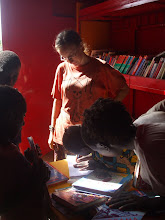It's been a busy couple of weeks! And I've only been able to spend one full day in my village since last Monday, because the activities have been taking place elsewhere. But my little demo plot is growing well, everything sprouted nicely, so I'm excited to get back to it. Visiting the fields is more fun now, too, because everyone is out there working most of the day. I'm learning to weed and thin with the "ngosi", a hand tool, which is laborious but effective. Finally, there is enough green material growing for animals to graze, so I hope our poor, bony horses start to fill out soon too. They're working just as hard as the people! Anyway, last Monday I took two girls from the village to Kaolack. The same program I'm working with on the bookmobile (10,000 filles) was putting on a five-day camp to discuss democracy, human rights, and gender equality. The camp was led entirely in English, by a group of college students from Goshan College. They did an awesome job! Though the village girls obviously don't speak English well (most not at all) we helped organize tables to mix them in with girls from Kaolack who did, and thus get the information translated. Kate and I were the two Peace Corps Volunteers there. Our role was to advise the students when they had questions about the activities they'd planned, and to be a translation resource if the girls had questions that needed answering in French or Wolof. The camp consisted of discussions, in which the girls participated fabulously well, and also games and activities. Some educational activities were writing mock political platforms (If I were President of Senegal...), and designing a flag representing democracy, and poetry writing on one of the Universal Human Rights (one girl wrote a stunning poem, in English, about how humanity transcends national boundries and differences in skin color; it was so good! Really blew me away.), and a collage project addressing stereotypes of women (these turned out amazing, too) there was also reading articles about Rosa Parks and Martin Luther King, Jr., and talks led by the very educated Mme. Vaughn (founder of the NGO) about what Islam teaches about gender equality. There were ice-breaking games, too, and possibly the highlight: group skits about womens' rights, all done in English, with the girls helping one another to understand. The skits turned out wonderfully! The girls really enjoyed it, and I could see them blossoming and gaining confidence each subsequent day of camp. It was a totally alien environment for so many of them, but they got so much out of it, really learned a huge amount, interacted with one another, and had a great time. One of the best things for me was Wednesday evening, when we built an American-style campfire. Somehow they'd found marshmallows in Kaolack, and bought butter cookies and chocolate spread. Thus, we introduced 30 Senegalese teenagers to the deliciousness of s'mores. Oh, they loved them! And I'm sure it was the first time any of them roasted a marshmallow over an open fire. After the gooey dessert, we had story time. Kate recited versions of "Goldilocks and the Three Bears" and "The Three Little Pigs", which I translated into (pretty awful) Wolof as "Fatou and the Three Hyenas" and "The Three Little Chickens and the Big, Bag Dog". I think my imperfect language skills made the girls laugh all the harder. The stories were acted out by the Goshan students, which was hilarious! Everyone had a marvelous time that night. In short, the camp was a huge success.
As I write this I am actually in Kolda, a city to the South of The Gambia. We just finished our last day of the Sustainable Agriculture Summit, which was a really useful three days of discussion about the agriculture program, reviewing the project plan and going over possible activities for the rainy season. Kolda is very different from the area I'm used to. It is lush and green, covered with trees, and the melodic sounds of the Pulaar language are more common here than Wolof. The huts in the surrounding villages are round, with thatch roofs reaching halfway down the sides, so they look like fat toadstools. I think it's adorable! And though corners are handy for propping up things like bookshelves and beds, I rather envy the Kolda Volunteers their novel circular huts. Going through The Gambia to get here was an interesting experience, too. It took around two hours, border to border, which included waiting for a ferry to carry us across the river. I had a tasty grilled chicken sandwich at the dock: grilled chicken, macaroni, fried potatoes, lettuce, tomato, and ground black pepper, all for only 500cfa. A marvelous treat for only "temere"!
 Learning about Martin Luther King, Jr. His "I have a dream" speech was translated into French in these booklets, along with other information about the Civil Rights Movement. If you want to learn more about the program that put on this camp, go to 10,000 Girls' website: http://10000girls.org/
Learning about Martin Luther King, Jr. His "I have a dream" speech was translated into French in these booklets, along with other information about the Civil Rights Movement. If you want to learn more about the program that put on this camp, go to 10,000 Girls' website: http://10000girls.org/



